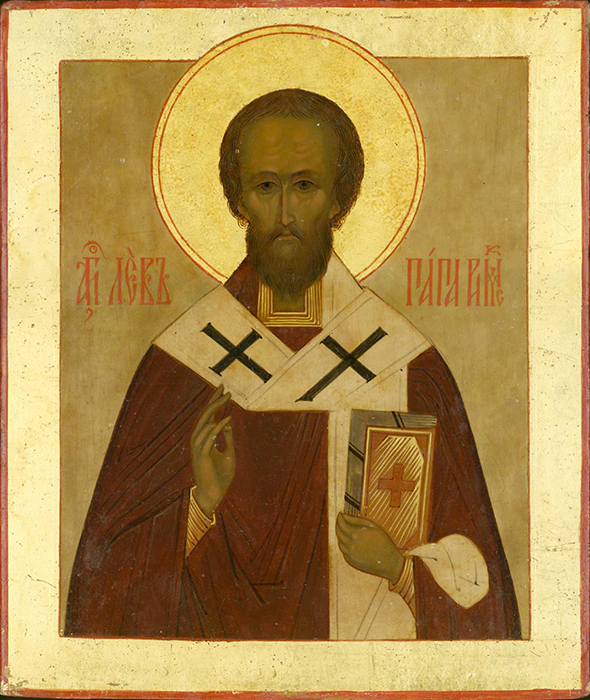
On February 18th by old calendar the church commemorates St Leo the Great, one of the holy Roman hierarchs and a fighter for Orthodoxy. St Leo lived in a tragic and significant era, when Western and Eastern Christians, while still constituting the One Church, had already lost their political unity. How did St Leo glorify God and what are his services to the church?
Early Ministry
Leo was born in Italy. The exact time and place of his birth are unknown. Judging by the absence of quotations from ancient authors in his numerous letters and epistles, Leo’s education was rather ecclesiastical than classical. We do not know anything about the early stage of his life. From a letter written by St Augustine we learn that in 418 the acoluthus (analogue to the eastern subdeacon) Leo arrives in Africa with a letter from the future Pope St Sixtus III, condemning Pelagius (Aug. Ep. 191. 1). During the reign of Pope Celestine I (422-432), Leo, already in the rank of senior archdeacon, takes part in shaping the position of the Roman Church in the Nestorian dispute. He instructs St John Cassian, one of the most prominent founders of Western monasticism, to write a treatise refuting the heresy of Nestorius. During Leo’s stay with a diplomatic mission in Gaul in 440, he was overtaken by the news of the death of St Sixtus III and his absentee election to the Roman Throne.

Strengthening the Roman See in the West
The beginning of St Leo’s prelacy was marked by a significant strengthening of the Roman Church throughout the West. This could be explained by Rome being the only apostolic see in the region, the supreme apostles’ martyrdom site and, more importantly, the former capital of the Roman Empire. The bishops of the western regions were still in the habit of seeking advice from Rome in doctrinal and disciplinary questions. This tendency only got stronger by the 5th century, characterized by the constant raids of the barbarians, bringing with them chaos and devastation. Indicatively, the African episcopate, after banning appeals to Rome by a conciliar decision in 424, now found itself in the orbit of Roman influence. While recognizing that local issues should be decided at local councils, Pope Leo actively intervened and demanded accountability in African affairs (Leo Magn. Ep. 12. 13). A similar situation was observed in relation to other Western churches with the support of Emperor Valentinian III.

St Leo and the Papacy
The pontificate of St Leo is notable for the fact that it was during his reign and in his writings that the doctrine of the Roman primacy (some elements of which had already appeared in the works of his predecessors) obtained its final wording. Pope Leo based his argumentation on the works of St Damasus I, St Siricius and St Innocent I, as well as the decisions of some Councils (Council of Serdica, 343; Council of Aquileia, 381). He methodized the Roman claims to supremacy, based on the primacy of St Peter and, with due respect to equal dignity of the bishops, emphasized their difference in rank, where the primates of the important sees have more authority than some of their brethren. According to St Leo, a bishop’s authority is limited to the diocese, while the concern of the bishop of Rome, as the successor of St Peter’s ministry, extends to the entire Catholic Church (Ep. 14. 1; Serm. 5. 2). St Leo hardly suspected what this doctrine would result in. However, at that moment in history, in view of both secular and ecclesiastical power vacuum on the belligerent periphery, as well as the resulting spread of heresies, the influence and concern of the strong Orthodox see in Rome was sufficiently justified.

The Council of Chalcedon
St Leo played an outstanding role in organizing the 4th Ecumenical Council in 451. The Pope was represented there by his legates, who brought his famous Tome to St Flavian of Constantinople. As a result, his message, approved by the Fathers of the Council (the Fathers, upon reading the message of Leo, exclaimed, “We are hearing the voice of St Peter!”, “It is Peter speaking through Leo’s mouth!”), formed the basis of the Chalcedonian dogma, binding for the entire church. The Council determined that according to church teaching, the Divine and the human natures are united in the Person of Jesus Christ, the incarnate God the Word. The Council of Chalcedon embodied the triumph of St Leo. At the same time, the Council, with its 28th canon, exalted the Throne of Constantinople, placing it second after Rome, against which subsequent Roman pontiffs unsuccessfully fought for centuries. As we can see, the doctrine of the Roman primacy, although not directly denied (and sometimes even supported) by the Eastern bishops, was strictly limited by the conciliar structure of the church.

The Pope Meets Attila
Finally, one of the brightest moments in St Leo’s biography is related to Attila, the leader of the Huns. In 452, hordes of barbarians invaded Italy, destroying many cities, including such important ones as Milan and Aquileia. Pope Leo took part in the Roman embassy at the headquarters of Attila, trying to dissuade him from destroying Rome, which would cause enormous damage to ancient civilization and culture. According to the Pope’s secretary, the historian Prosper of Aquitaine, Attila was amazed at Leo’s words, as well as his courage. He was even more struck however by the beauty and splendor of the Roman high priest’s holy vestments (Prosper. Chron. An. 455). As a result, Leo persuaded Attila to leave Italy, although this was hardly possible without great material costs. Saint Leo also spared no expense in ransoming the captured prisoners, and ransomed them regardless of their religion.

The Pope died in 461 under unknown circumstances. His relics rest in the Basilica of St Peter in the Vatican.





